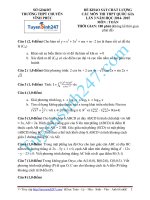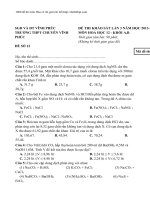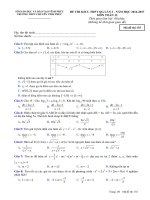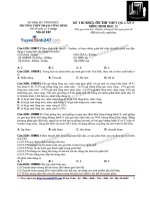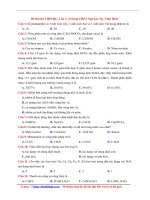Tải Đề thi thử THPT Quốc gia môn Tiếng Anh năm 2016 trường THPT Phạm Công Bình, Vĩnh Phúc (lần 3) - Đề thi thử THPT Quốc gia năm 2016 môn Tiếng Anh có đáp án
Bạn đang xem bản rút gọn của tài liệu. Xem và tải ngay bản đầy đủ của tài liệu tại đây (132.68 KB, 9 trang )
<span class='text_page_counter'>(1)</span><div class='page_container' data-page=1>
<b>SỞ GD&ĐT VĨNH PHÚC</b>
<b>TRƯỜNG THPT PHẠM CÔNG BÌNH</b>
(Đề thi gồm có 06 trang)
<b>ĐỀ KTCL ƠN THI THPT QG KHỐI 12 LẦN</b>
<b>3 </b>
<b>NĂM HỌC 2015-2016</b>
<b>Môn: TIẾNG ANH </b>
<i>Thời gian làm bài: 90 phút, không kể thời gian</i>
<i>phát đề</i>
<b>Mã đề 139</b>
<b>Họ và tên thí sinh:……….……….….………; Số báo danh:………</b>
<i><b>Section A (8 points)</b></i>
<i><b>Mark the letter A, B, C, or D on your answer sheet to indicate the word that differs from the rest in</b></i>
<i><b>the position of the main stress in each of the following questions:</b></i>
<b>Câu 1: </b> <b>A. cartoon</b> <b>B. answer</b> <b>C. open</b> <b>D. paper</b>
<b>Câu 2: </b> <b>A. diseases</b> <b>B. important</b> <b>C. community</b> <b>D. organize</b>
<b>Câu 3: </b> <b>A. appropriate</b> <b>B. secretary</b> <b>C. accuracy</b> <b>D. ambulance</b>
<i><b>Read the following passage and mark the letter A, B, C, or D on your answer sheet to indicate the</b></i>
<i><b>correct answer:</b></i>
The history of clinical nutrition, or the study of the relationship between health and how the body
takes in and utilizes food substances, can be divided into four distinct eras: the first began in the
nineteenth century and extended into the early twentieth century when it was recognized for the first
time that food contained constituents that were essential for human function and that different foods
provided different amounts of these essential agents. Near the end of this era, research studies
demonstrated that rapid weight loss was associated with nitrogen imbalance and could only be rectified
by providing adequate dietary protein associated with certain foods.
</div>
<span class='text_page_counter'>(2)</span><div class='page_container' data-page=2>
<b>of nutritional therapies in medicine. Reckless claims were made for effects of vitamins that went far</b>
<b>beyond what could actually be achieved from the use of them. </b>
In the third era of nutritional history in the early 1950's to mid-1960's, vitamin therapy began to fall
<b>into disrepute. Concomitant with this, nutrition education in medical schools also became less</b>
popular. It was just a decade before this that many drug companies had found their vitamin sales
<b>skyrocketing and were quick to supply practicing physicians with generous samples of vitamins and</b>
literature extolling the virtue of supplementation for a variety of health-related conditions.
Expectations as to the success of vitamins in disease control were exaggerated. As is known in
retrospect, vitamin and mineral therapies are much less effective when applied to health-crisis
conditions than when applied to long-term problems of under nutrition that lead to chronic health
problems.
<b>Câu 4: What does the passage mainly discuss?</b>
<b>A. The effects of vitamins on the human body</b>
<b>B. The history of food preferences from the nineteenth century to the present</b>
<b>C. The stages of development of clinical nutrition as a field of study</b>
<b>D. Nutritional practices of the nineteenth century</b>
<b>Câu 5: It can be inferred from the passage that which of the following discoveries was made during</b>
the first era in the history of nutrition?
<b>A. Vitamins were synthesized from foods.</b>
<b>B. Effective techniques of weight loss were determined.</b>
<b>C. Protein was recognized as an essential component of diet.</b>
<b>D. Certain foods were found to be harmful to good health.</b>
<b>Câu 6: The word "tempting" is closest in meaning to _____________.</b>
<b>A. attractive</b> <b>B. necessary</b> <b>C. correct</b> <b>D. realistic</b>
<b>Câu 7: It can be inferred from the passage that medical schools began to teach concepts of nutrition in</b>
order to ____________.
<b>A. encourage medical doctors to apply concepts of nutrition in the treatment of disease</b>
<b>B. support the creation of artificial vitamins</b>
<b>C. convince medical doctors to participate in research studies on nutrition</b>
<b>D. convince doctors to conduct experimental vitamin therapies on their patients</b>
<b>Câu 8: The word "Reckless" is closest in meaning to ___________.</b>
<b>A. informative</b> <b>B. recorded</b> <b>C. urgent</b> <b>D. irresponsible</b>
<b>Câu 9: The word “them" refers to ______________.</b>
</div>
<span class='text_page_counter'>(3)</span><div class='page_container' data-page=3>
<b>Câu 10: Why did vitamin therapy begin losing favor in the 1950’s?</b>
<b>A. Claims for the effectiveness of vitamin therapy were seen to be exaggerated.</b>
<b>B. The public lost interest in vitamins.</b>
<b>C. Nutritional research was of poor quality</b>
<b>D. Medical schools stopped teaching nutritional concepts.</b>
<b>Câu 11: The phrase "concomitant with" is closest in meaning to ______________.</b>
<b>A. in dispute with</b> <b>B. in conjunction with</b> <b>C. prior to</b> <b>D. in regard to</b>
<b>Câu 12: The word "skyrocketing" is closest in meaning to ______________.</b>
<b>A. increasing rapidly</b> <b>B. internationally popular</b>
<b>C. acceptable</b> <b>D. surprising</b>
<b>Câu 13: The paragraph following the passage most probably discusses ___________.</b>
<b>A. problems associated with undernutrition</b> <b>B. the fourth era of nutrition history</b>
<b>C. why nutrition education lost its appeal</b> <b>D. how drug companies became successful</b>
<i><b>Mark the letter A, B, C, or D on your answer sheet to indicate the correct answer to each of the</b></i>
<i><b>following questions </b></i>
<b>Câu 14: Thomas Edison ________ many new appliances using electricity during his long career.</b>
<b>A. was invented</b> <b>B. invented</b> <b>C. who invented</b> <b>D. inventing</b>
<b>Câu 15: I haven’t seen Manh ………..Christmas.</b>
<b>A. from</b> <b>B. since</b> <b>C. for</b> <b>D. during</b>
<b>Câu 16: Mary, ………knew nothing about the mountain, thought it would be safe to climb</b>
alone.
<b>A. whose</b> <b>B. whom</b> <b>C. that</b> <b>D. who</b>
<b>Câu 17: People ... outlook on life is optimistic are usually happy people.</b>
<b>A. whose</b> <b>B. which</b> <b>C. that</b> <b>D. whom</b>
<b>Câu 18: Fax machine...send or receive letter quickly.</b>
<b>A. is used to</b> <b>B. is used for</b> <b>C. used to</b> <b>D. used for</b>
<b>Câu 19: A number of political prisoners...since Independent Day.</b>
<b>A. have released</b> <b>B. was released</b> <b>C. released</b> <b>D. have been released</b>
<b>Câu 20: He did finally come with us, although it took a long time to...him.</b>
<b>A. persuade</b> <b>B. take</b> <b>C. believe</b> <b>D. permit</b>
<b>Câu 21: Joe, who is one of my elder sister's sons, is my favorite .</b>
<b>A. grandson</b> <b>B. uncle</b> <b>C. niece</b> <b>D. nephew</b>
<b>Câu 22: Dalat city is a popular...for art lovers.</b>
</div>
<span class='text_page_counter'>(4)</span><div class='page_container' data-page=4>
<b>Câu 23: ………..did it take you to get used to wearing glasses?</b>
<b>A. How far</b> <b>B. How often</b> <b>C. How much</b> <b>D. How long</b>
<b>Câu 24: __________ lay its eggs in the sand on the beach than it goes back to the sea.</b>
<b>A. No sooner a turtle does</b> <b>B. No sooner does a turtle</b>
<b>C. Does no sooner a turtle</b> <b>D. A turtle does no sooner</b>
<b>Câu 25: I didn't set _________ to start an argument, it just happened.</b>
<b>A. off</b> <b>B. up</b> <b>C. out</b> <b>D. about</b>
<b>Câu 26: Please _______your cigarette. I am going to get choked.</b>
<b>A. put out</b> <b>B. put aside</b> <b>C. blowout</b> <b>D. cut down</b>
<b>Câu 27: Is there anyone who _______ the plan put forward by the committee?</b>
<b>A. objects</b> <b>B. differs</b> <b>C. disagrees</b> <b>D. opposes</b>
<b>Câu 28: Thinh: “How lovely your pets are!” – Tuan: “____________”.</b>
<b>A. I love them, too</b> <b>B. Really? They are</b>
<b>C. Can you say that again</b> <b>D. Thank you, it’s nice of you to say so</b>
<b>Câu 29: Jogging every day will_______ you good.</b>
<b>A. do</b> <b>B. keep</b> <b>C. help</b> <b>D. make</b>
<b>Câu 30: But for their help, he _________.</b>
<b>A. wouldn’t have failed</b> <b>B. has not failed</b>
<b>C. has failed</b> <b>D. would have failed</b>
<b>Câu 31: Tom." Would you like something else?" - Bean: “__________________."</b>
<b>A. Yes, I like everything</b> <b>B. Two, please.</b>
<b>C. That's all. Thank you</b> <b>D. No, I wouldn't.</b>
<b>Câu 32: Most of the computers in the laboratory are _________now.</b>
<b>A. out of function</b> <b>B. out of work</b> <b>C. out of order</b> <b>D. out of working</b>
<i><b>Read the following passage and mark the letter A, B, C, or D on your answer sheet to indicate the</b></i>
<i><b>correct word:</b></i>
</div>
<span class='text_page_counter'>(5)</span><div class='page_container' data-page=5>
Doctors, for example, will be able to cure any ……[<7>]…....The environment will be improved
because it will be possible to take the polluted air we breathe and ……[<8>]…....it clean again. But
perhaps the most exciting thought of all is ……[<9>]…....we won’t have to wait a thousand years for
nanotechnology – many people believe there is a good chance it will ……[<10>]…....our lifetime.
<b>Câu 33: A. changed</b> <b>B. made</b> <b>C. done</b> <b>D. gone</b>
<b>Câu 34: A. something</b> B. nothing C. anything D. nonething
<b>Câu 35: A. invented</b> <b>B. inventions</b> <b>C. inventing</b> <b>D. inventors</b>
<b>Câu 36: A. plenty of</b> <b>B. great deal</b> <b>C. amount of</b> <b>D. number of</b>
<b>Câu 37: A. mentioning</b> <b>B. speaking</b> <b>C. talking</b> <b>D. saying</b>
<b>Câu 38: A. bring about</b> <b>B. set out</b> <b>C. take off</b> <b>D. run out</b>
<b>Câu 39: A. disorder</b> <b>B. illness</b> <b>C. problem</b> <b>D. trouble</b>
<b>Câu 40: A. make</b> <b>B. find</b> <b>C. bring</b> <b>D. become</b>
<b>Câu 41: A. which</b> <b>B. what</b> <b>C. that</b> <b>D. where</b>
<b>Câu 42: A. get out</b> <b>B. do up</b> <b>C. come in</b> <b>D. set off</b>
<i><b>Mark the letter A, B, C, or D on your answer sheet to indicate the word whose underlined part is</b></i>
<i><b>pronounced differently from that of the rest in each of the following questions</b></i>
<b>Câu 43: A. although</b> <i><b>B. thank</b></i> <i><b>C. these</b></i> <b>D. without</b>
<b>Câu 44: A. tool</b> <b>B. good</b> <b>C. tooth</b> <b>D. food</b>
<b>Mark the letter A, B, C or D on your answer sheet to indicate the word or phrase that is</b>
<b>OPPOSITE in meaning to the underlined part in each of the following questions </b>
<b>Câu 45: It was apparent from her face that she was really upset.</b>
<b>A. obvious</b> <b>B. indistinct</b> <b>C. transparent</b> <b>D. evident</b>
<b>Câu 46: My cousin tends to look on the bright side in any circumstance.</b>
<b>A. be optimistic</b> <b>B. be pessimistic</b> <b>C. be confident</b> <b>D. be smart</b>
<b>Read the following passage and mark the letter A, B, C, or D on your answer sheet to indicate</b>
<b>the correct answer .</b>
</div>
<span class='text_page_counter'>(6)</span><div class='page_container' data-page=6>
Many of more important air pollutants, such as sulfur oxides, carbon monoxides and nitrogen
oxides are found in nature. As the Earth developed, the concentration of these pollutants was altered by
<b>various chemical reactions; they became components in biogeochemical cycles. These serve as an air</b>
purification scheme by allowing the compounds to move from the air to the water or soil. On a global
basis, nature's output of these compounds dwarfs that resulting from human activities.
<b>However, human production usually occurs in a localized area, such as a city. In such region,</b>
human output may be dominant and may temporarily overload the natural purification scheme of the
cycles. The result is an concentration of noxious chemicals in the air. The concentrations at which the
adverse effects appear will be greater than the concentrations that the pollutants would have in the
absence of human activities. The actual concentration need not be large for a substance to be a
pollutant; in fact, the numerical value tells us little until we know how much of an increase this
represents over the concentration that would occur naturally in the area. For example, sulfur dioxide
<i><b>has detectable health effects at 0. 08 parts per million (ppm), which is about 400 times its natural</b></i>
level. Carbon monoxide, however has a natural level of 0. 1 ppm and is not usually a pollutant until its
level reaches about 15 ppm.
<b>Câu 47: The word "detectable " is closest in meaning to ___.</b>
<b>A. special</b> <b>B. separable</b> <b>C. beneficial</b> <b>D. measurable.</b>
<b>Câu 48: The word "localized " is closest in meaning to ___.</b>
<b>A. specified</b> <b>B. circled</b> <b>C. encircled</b> <b>D. surrounded.</b>
<b>Câu 49: The word "these" in the second paragraph refers to ____.</b>
<b>A. the compounds moved to the water or soil</b> <b>B. the various chemical reactions.</b>
<b>C. the pollutants from the developing Earth</b> <b>D. the components in biogeochemical cycles.</b>
<b>Câu 50: </b>According to the passage, the numerical value of the concentration level of a substance is
<b>only useful if ________.</b>
<b>A. the other substances in the area are known</b> <b>B. it can be calculated quickly.</b>
<b>C. it is in a localized area</b> <b>D. the natural level is also known.</b>
<b>Câu 51: It can be inferred from the first paragraph that ____.</b>
<b>A. the definition of air pollution will continue to change.</b>
<b>B. water vapor is an air pollutant in localized areas.</b>
<b>C. Most pollutants today can be seen or smelled.</b>
<b>D. a substance becomes an air pollutant only in cities.</b>
<b>Câu 52: According to the passage, human- generated air pollution in localized regions ____.</b>
<b>A. will react harmfully with natural pollutants.</b>
</div>
<span class='text_page_counter'>(7)</span><div class='page_container' data-page=7>
<b>C. will damage area outside of the localized regions.</b>
<b>D. can be dwarfed by nature's output of pollutants.</b>
<b>Câu 53: The word "adversely " is closest in meaning to ___.</b>
<b>A. considerably</b> <b>B. quickly</b> <b>C. negatively.</b> <b>D. admittedly</b>
<b>Câu 54: Which of the following is best supported by the passage?</b>
<b>A. Scientists should be consulted in order to establish uniform limits for all air pollutants.</b>
<b>B. Human activities have been effective in reducing air pollution.</b>
<b>C. One of the most important steps in preserving natural lands is to better enforce air pollution </b>
laws.
<b>D. To effectively control pollution, local government should regularly review their air pollution </b>
laws.
<b>Câu 55: For which of the following reasons can natural pollutants play an important role in controlling</b>
air pollution?
<b>A. They have existed since the Earth developed.</b>
<b>B. They occur in greater quantities than other pollutants.</b>
<b>C. They're less harmful to living beings than other pollutants.</b>
<b>D. They function as part of a purification process.</b>
<b>Câu 56: What does the passage mainly discuss?</b>
<b>A. The effects of compounds added to the atmosphere</b>
<b>B. The economic impact of air pollution.</b>
<b>C. What constitutes an air pollutant</b>
<b>D. How much harm air pollutants can cause.</b>
<i><b>Mark the letter A, B, C, or D on your answer sheet to show the underlined part that needs</b></i>
<i><b>correction:</b></i>
<b>Câu 57: This is the floppy disk which I have been looking for it all this morning.</b>
<b>A. which</b> <b>B. it</b> <b>C. morning</b> <b>D. is</b>
<b>Câu 58: The last payment shouldn't make until all the work has been completed and carefully checked.</b>
<b>A. completed</b> <b>B. has been</b> <b>C. checked</b> <b>D. make</b>
<b>Câu 59: Eggs may be boiled in the shell, scrambled, fried, and cooked in the countless another ways.</b>
<b>A. the shell</b> <b>B. fried</b> <b>C. another</b> <b>D. boiled</b>
<b>Câu 60: Shortly before the Allied invasion of Normandy, Ernest Hemingway has gone to London as a</b>
<i>war correspondent for Colliers.</i>
<b>A. invasion</b> <b>B. has gone</b> <b>C. Shortly</b> <b>D. correspondent</b>
</div>
<span class='text_page_counter'>(8)</span><div class='page_container' data-page=8>
<b>A. Not until</b> <b>B. at home</b> <b>C. that I realized</b> <b>D. on my way</b>
<i><b>Mark the letter A, B, C, or D on your answer sheet to indicate the word or phrase that is</b></i>
<i><b>CLOSEST in meaning to the underlined part in each of the following questions:</b></i>
<b>Câu 62: Children normally feel a lot of anxiety about their first day at school.</b>
<b>A. agitation</b> <b>B. tranquility</b> <b>C. composure</b> <b>D. contentment</b>
<b>Câu 63: “What I’ve got to say to you now is strictly off the record and most certainly not for</b>
publication,” said the government official to the reporter.
<b>A. not yet official</b> <b>B. beside the point</b> <b>C. not recorded</b> <b>D. not popular</b>
<b>Câu 64: I take my hat off to all those people who worked hard to get the contract.</b>
<b>A. encourage</b> <b>B. congratulate</b> <b>C. respect</b> <b>D. welcome</b>
</div>
<span class='text_page_counter'>(9)</span><div class='page_container' data-page=9></div>
<!--links-->
